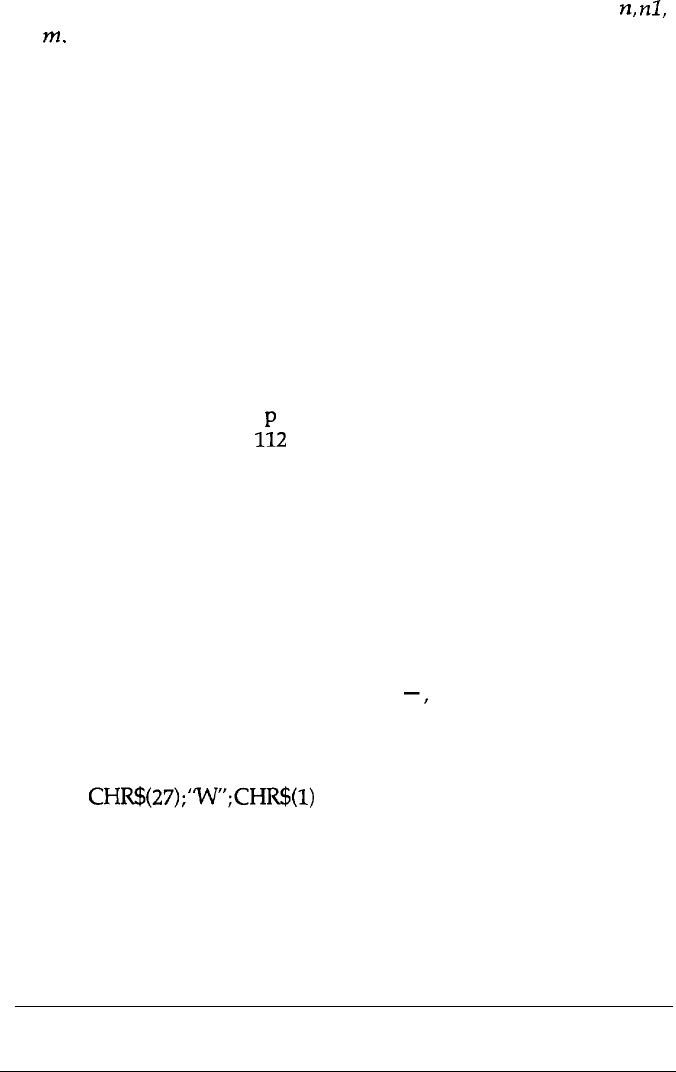Printer User Manual
Table Of Contents
- FRONT MATTER
- TABLE OF CONTENTS
- INTRODUCTION
- CHAP 1-SETTING UP THE PRINTER
- CHAP 2-PAPER HANDLING
- CHAP 3-USING THE PRINTER
- CHAP 4-USING SOFTWARE AND GRAPHICS
- Using the LQ-2550 With Application Programs
- Computer-Printer Communication
- Enhancing Your Printing
- Graphics
- User-Defined Characters
- Designing Your Characters
- Design Grids
- Data Numbers
- Sending Information to Your Printer
- Printing User-Defined Characters
- Copying ROM Characters to RAM
- Letter Quality Characters
- Proportional Mode Characters
- Superscripts and Subscripts
- The Graphics Command
- Column Reservation Numbers
- A simple Graphics Program
- Using Hand-Calculated Data to Print Graphics
- Using Software and Graphics
- Mixing Print Styles
- CHAP 5-MAINTENANCE AND TRANSPORTATION
- CHAP 6-TROUBLESHOOTING
- Troubleshooting
- Problems and Solutions
- The Printer Does Not Print
- The Printer Stops Printing
- The Printout is Spaced Incorrectly
- The Printout is Faint or Uneven
- The Printout is Not what You Expect
- Single Sheets Do Not Feed Properly
- Continuous Paper Does Not Feed Properly
- Cut Sheet Feeder Does Not Load Paper Correctly
- The Short Tear-Off Feature Does Not Work Properly
- Color Printing Is Not What You Expect
- Data Dump Mode
- CHAP 7-USING PRINTER OPTIONS
- CHAP 8-COMMAND SUMMARY
- APPENDIX A-TECHNICAL SPECIFICATIONS
- GLOSSARY
- INDEX

All three formats are equivalent, so you can pick the one best suited to
your purpose. Variables are represented by italicized letters such as
n,
nl,
and
m.
The variables are explained in the comments section.
Examples
The simplest type of command consists of sending a single character to
the printer. For instance, to print in condensed mode, you send the code
15.
ASCII code: SI
Decimal:
15
Hexadecimal: OF
More complex commands consist of two or more character codes. For
example, to print in the proportional mode the code format is the
following:
ASCII:
ESC
n
Decimal:
27
1:2
n
Hexadecimal: 1B 70 n
In this case n can be either 1 (on) or 0 (off), to begin or end proportional
printing. To turn on proportional printing from BASIC, use the following
command:
LPRINT CHR$(27);“p”;CHR$(l)
For the following commands that use only 0 or 1 for the variable, either
the ASCII codes 0 and 1 or the ASCII characters 0 and 1 can be used:
ESC U, ESC x, ESC p, ESC W, ESC S, ESC
-,
ESC %, and ESC w.
For example, in BASIC you can turn on double-wide with either of these
statements:
LPRINT CHR$(27);‘W”;CHR!$(l)
. . . . . . . . . . . . . . ASCII code
LPRINT CHR$(27);“W”;“l”
. . . . . . . . . . . . . . . . . . . ASCII character
Command Summary
8-3










